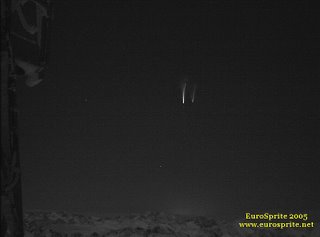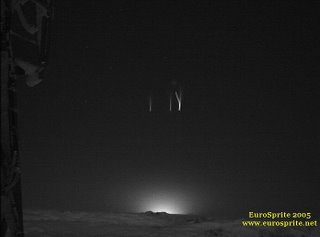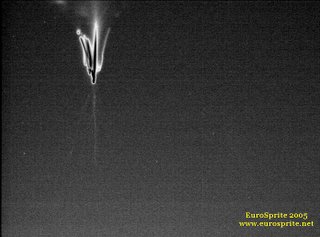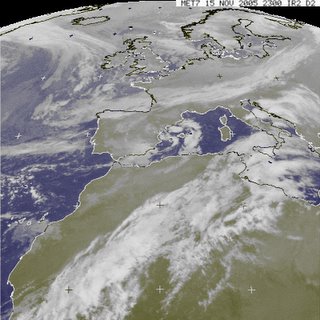15 November: sprites!
Four sprites have been found in the raw images obtained during the night of the "Icy Moonlight Spritewatch" (see post below)! Because the sprites did not trigger the detection algorithmn themselves but their earlier parent lightning flash, they were initially not uploaded to our control site and went undiscovered until Olivier went through all of the obtained images.
The sprites occurred in the evening of the 15th November at 22:12, 22:47, 22:51 and 23:15 UTC. The more precise time is in the image filename. As you can see, the sprites are in fact brighter than the moonlight reflected off the snow and clouds.




Close-ups were also obtained by the camera with telephoto lens, such as the last one, which has been edited to better show also the less luminous parts:

The storm was situated between the Spanish coast and Mallorca, and actually not even very large or electrically very active. Many images of the storm top flashes were obtained, which can be used as an optical indicator of lightning rates to compliment lightning detection systems.

The sprites of this night all belong to the columniform family of sprites. The last one is by some called an "angel" sprite because of its wings. Based on the detailed close-ups we obtained of column sprites during this campaign, would this vegetable be a good name, to match with the already accepted term carrot sprites?

Other new sprites that Olivier found were of October 7th by the camera at Puy de Dome, and one night before this one, November 14-15th, when there was a gap between the clouds.
The sprites occurred in the evening of the 15th November at 22:12, 22:47, 22:51 and 23:15 UTC. The more precise time is in the image filename. As you can see, the sprites are in fact brighter than the moonlight reflected off the snow and clouds.




Close-ups were also obtained by the camera with telephoto lens, such as the last one, which has been edited to better show also the less luminous parts:

The storm was situated between the Spanish coast and Mallorca, and actually not even very large or electrically very active. Many images of the storm top flashes were obtained, which can be used as an optical indicator of lightning rates to compliment lightning detection systems.

The sprites of this night all belong to the columniform family of sprites. The last one is by some called an "angel" sprite because of its wings. Based on the detailed close-ups we obtained of column sprites during this campaign, would this vegetable be a good name, to match with the already accepted term carrot sprites?

Other new sprites that Olivier found were of October 7th by the camera at Puy de Dome, and one night before this one, November 14-15th, when there was a gap between the clouds.

1 Comments:
Well thank you for giving me yet another geeky obsession :)
I have been a weather and solar event nut for many years and though I read about sprites before, I never delved into the subject until I stumbled across your blog.
Question: have you looked into any sonic phenomena associated with sprite (etc) discharge? I have been debating building a dish receiver for studying reports of sonic activity associated with auroral events at my home and wondered if similar reports have ever been made.
Post a Comment
<< Home